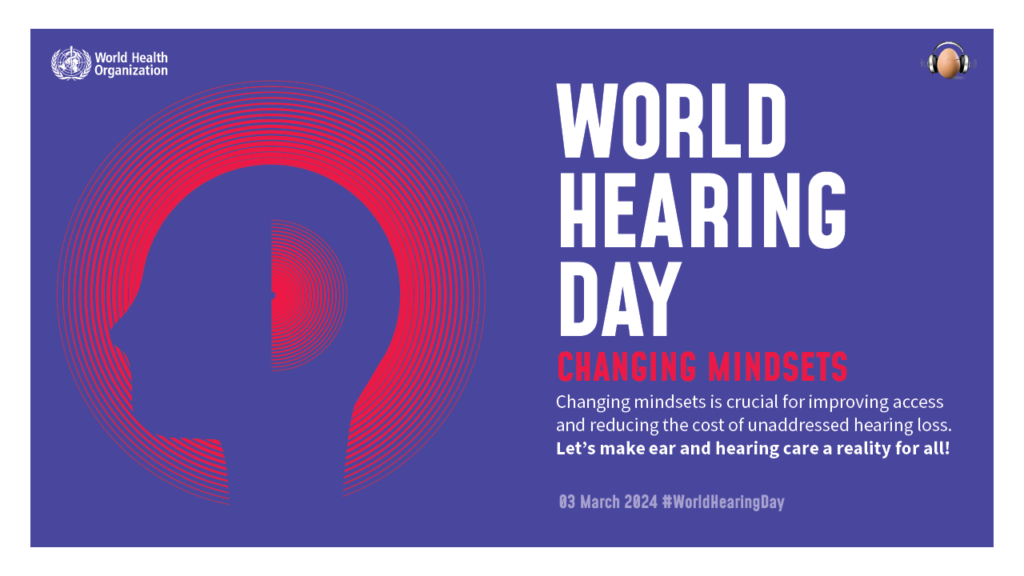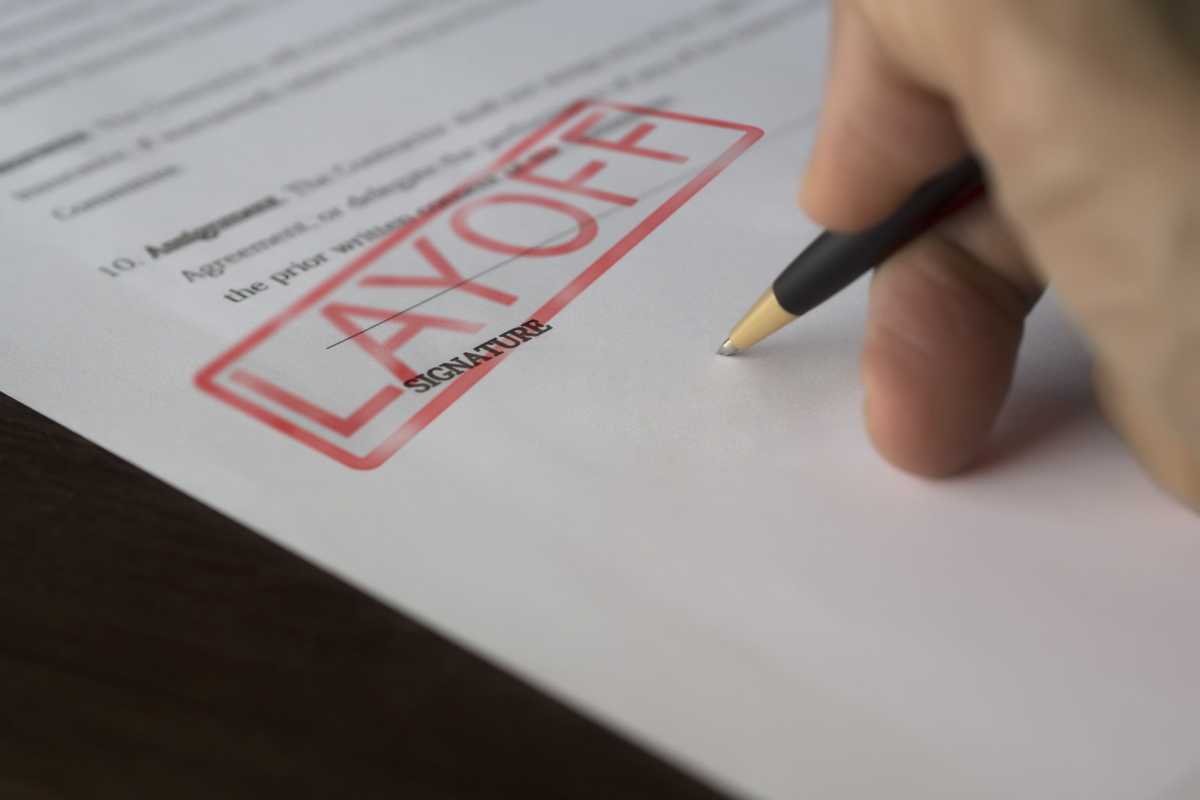World Hearing Day, commemorated annually on March 3, serves as a crucial reminder of the importance of hearing health and the impact of hearing loss on individuals worldwide.
Organized by the World Health Organization (WHO), the day aims to raise awareness, promote ear and hearing care and support the implementation of strategies to prevent and address hearing loss. Recent advancements in research and the development of innovative treatments that are transforming the landscape of hearing care are also highlighted on World Hearing Day.
The theme of this year’s World Hearing Day is “Changing Mindsets: Let’s Make Ear and Hearing Care a Reality for All!” It emphasizes the importance of hearing care being accessible to everyone.
Hearing loss affects people of all ages across the globe, with significant consequences for quality of life, education and employment opportunities.
“Hearing loss has often been referred to as an “invisible disability,” not just because of the lack of visible symptoms, but because it has long been stigmatized in communities and ignored by policymakers,” said WHO Director-General Tedros Adhanom Ghebreyesus.
According to the WHO, globally, over 1.5 billion people live with some degree of hearing loss.
The staggering figures underscore the urgent need for effective interventions and the development of accessible hearing care services.
Current treatments for hearing loss include hearing aids, cochlear implants, bone-anchored hearing systems, middle ear implants, assistive learning devices such as specialized telephones and amplified alarm clocks designed to improve daily communication and quality of life, medication, surgery and emerging new treatments such as gene therapy and regenerative medicine.
World Hearing Day 2024: Hear the Facts
Hearing problems affect people of all ages across the world. The statistics below highlight the prevalence, impact and challenges associated with hearing loss and related conditions, underscoring the importance of awareness, prevention, early detection and timely intervention.
Global Prevalence
Over 1.5 billion people worldwide suffer from some degree of hearing loss, according to the WHO.
The WHO estimates that by 2050, over 2.5 billion people will have some degree of hearing loss, with at least 700 million requiring hearing rehabilitation services.
Age and Hearing Loss
Approximately one-third of people over 65 years of age are affected by disabling hearing loss, with the prevalence significantly higher in South Asia, Asia Pacific and sub-Saharan Africa.
Hearing loss affects about 1.1 billion young people (aged between 12 and 35 years) due to exposure to noise in recreational settings.
Impact on Children
Over 34 million children worldwide suffer from disabling hearing loss, which can significantly impact their language development, education and social integration.
Early identification and intervention are crucial; however, less than ten percent of children in low-income countries have access to the services they need.
Economic Impact
Untreated hearing loss has a profound economic impact globally, with an estimated annual cost of $1 trillion. This cost includes healthcare costs (excluding the cost of hearing devices), costs of educational support, loss of productivity and societal costs.
Access to Treatment
Less than 20 percent of those who could benefit from hearing aids have access to them, primarily due to high costs, lack of awareness and limited availability in many parts of the world.
In low- to middle-income countries, the availability of ear and hearing care services is severely constrained, with instances where there is fewer than one ear, nose and throat (ENT) specialist per million population.
Noise Exposure
Noise-induced hearing loss remains one of the most common occupational hazards. It is estimated that around 16 percent of hearing loss in adults is attributable to occupational noise exposure.
Recreational exposure to loud sounds through activities such as attending loud concerts, using personal audio devices at high volumes and engaging in noisy sports without ear protection contributes significantly to the risk of hearing loss in younger populations.
The Role of Technology and Innovation
The advent of over-the-counter hearing aids and advancements in hearing technology, such as cochlear implants and bone-anchored hearing systems, offer hope for improved access and outcomes for many with hearing loss.
Despite these advancements, there remains a significant gap in the availability and use of such technologies, especially in low- and middle-income countries.
Common Hearing Conditions
Hearing conditions can vary widely in their causes, symptoms and impacts on individuals’ lives. They range from temporary and mild to permanent and profound, affecting people of all ages. Below is an overview of several common and distinct hearing conditions.
Conductive Hearing Loss
Conductive hearing loss occurs when sound waves are impeded in their journey through the outer ear, tympanic membrane (ear drum) or middle ear. This condition can result from various issues, including ear infections (otitis media), buildup of earwax (cerumen impaction), perforated eardrum, fluid in the middle ear or abnormalities of the ear structure. Conductive hearing loss may be temporary or permanent but often can be treated medically or surgically.
Sensorineural Hearing Loss
Sensorineural hearing loss (SNHL) is the most common type of permanent hearing loss. It occurs due to damage to the hair cells in the cochlea (inner ear) or the auditory nerve. Causes can include aging (presbycusis), exposure to loud noise, genetic predisposition, certain medications (ototoxic drugs) and various diseases. Treatments often involve the use of hearing aids, cochlear implants or other assistive devices, as the condition is generally irreversible.
Mixed Hearing Loss
Mixed hearing loss is a combination of conductive and sensorineural hearing loss. This means there is damage in both the outer or middle ear and the inner ear (cochlea) or auditory nerve. Treatment strategies for mixed hearing loss typically address both components, possibly combining surgery, medications and the use of hearing aids or cochlear implants.
Tinnitus
Also known as “ringing in the ears,” tinnitus is characterized by hearing noises that are not caused by an external sound. The noise can be ringing, buzzing, hissing, whistling or other sounds. Tinnitus can be a symptom of various underlying conditions, such as hearing loss, ear injury or a circulatory system disorder. While there is no cure for most types of tinnitus, treatments can help manage the condition, including sound therapy, counseling and hearing aids.
Auditory Processing Disorder
Auditory processing disorder (APD), also known as central auditory processing disorder, affects the brain’s ability to process auditory information. Individuals with APD may have normal hearing sensitivity, but they struggle to understand speech, especially in noisy environments, differentiate similar sounds or follow complex auditory instructions. Management often involves auditory training, speech therapy and the use of assistive listening devices.
Meniere’s Disease
Meniere’s disease is a disorder of the inner ear that can lead to dizzy spells (vertigo) and hearing loss. Symptoms may include fluctuating hearing loss, tinnitus, ear fullness and severe vertigo attacks. The cause of Meniere’s disease is not well understood, and there is no cure, but treatments such as dietary changes, medications and therapy can help manage symptoms.
Otosclerosis
Otosclerosis involves abnormal bone growth in the middle ear, which can lead to hearing loss. The condition typically affects the stapes bone, one of the tiny ossicles in the middle ear, preventing it from vibrating in response to sound. Otosclerosis can cause conductive hearing loss, sensorineural hearing loss or a combination of both. Treatment may include hearing aids or surgical intervention to replace the stapes bone with a prosthetic.
Age-Related Hearing Loss (Presbycusis)
Presbycusis is the gradual loss of hearing that occurs as people get older. This type of hearing loss is primarily sensorineural, resulting from the degeneration of inner ear structures. It affects both ears and leads to difficulty hearing high-frequency sounds and understanding speech amidst background noise. Hearing aids, assistive devices and communication strategies are common treatments.
New Treatments for Hearing Loss
Gene therapies, stem cell regeneration, next-generation hearing aid technology and cochlear implants are some of the areas of research with significant promise for the development of new treatments for hearing loss.
Companies Developing Treatments for Hearing Loss
Fennec Pharmaceuticals: Fennec focuses on combating cisplatin-induced hearing loss in pediatric cancer patients with its US Food and Drug Administration (FDA)-approved drug, Pedmark (sodium thiosulfate injection). The drug helps reduce the risk of hearing loss caused by cisplatin chemotherapy in children with localized, non-metastatic solid tumors.
Sensorion: France-based Sensorion is working to treat genetic forms of deafness using its small molecule drug, SENS-401, to treat sudden sensorineural hearing loss (SSNHL) and prevent cisplatin-based chemotherapy-induced hearing loss resulting from inner ear lesions that lead to nerve degeneration and sensory hair cell loss. SENS-401 was granted orphan drug designation by the FDA for preventing platinum-induced ototoxicity in pediatric patients. SENS-401 is currently being evaluated in a Phase IIa clinical trial for the prevention of residual hearing loss in patients scheduled for cochlear implantation, and in a Phase II trial for the prevention of cisplatin-induced hearing loss.
Sound Pharmaceuticals: Seattle-based Sound Pharmaceuticals is developing treatments for various inner ear conditions, including Meniere’s disease, noise-induced hearing loss (NIHL) and aminoglycoside-induced ototoxicity. The company’s lead candidate, SPI-1005, aims to treat sensorineural diseases of the inner ear by mimicking the activity of glutathione peroxidase, a critical enzyme in the cochlea for auditory function. SPI-1005 is currently being evaluated in a pivotal Phase III trial for the treatment of Meniere’s disease and a Phase IIb trial for aminoglycoside-induced ototoxicity among cystic fibrosis patients treated with aminoglycoside antibiotics. Sound presented positive interim data from its Phase IIb STOP Ototoxicity trial at the Association for Research in Otolaryngology (ARO) Midwinter Meeting that took place in early February this year in Anaheim, California.
Gene Therapies for Hearing Loss
Gene therapies to correct genetic mutations that cause hearing loss is an active area of development. Common mutations that lead to hearing loss include mutations in the GJB2 (Connexin 26), SLC26A4, OTOF, MYO7A, CDH23, MITF and POU3F4 genes. There are a number of companies and academic institutions developing gene therapies for ear-related conditions leading to hearing loss.
Harvard Medical School: Earlier this year, researchers at the Massachusetts Eye and Ear Infirmary and Harvard Medical School showed how a novel gene therapy could restore hearing in children who had a condition called DFNB9, which results in total deafness due to an inherited mutation in the OTOF gene. The gene codes for a protein that is important for transmitting signals from the ear to the brain. Of the six children (ages one to seven) treated with the gene therapy targeting the OTOF mutation, five children showed improvement in hearing over the 26-week trial. The researchers said four of the outcomes were “robust.”
Regeneron Pharmaceuticals: The pharma giant is developing DB-OTO, an OTOF-targeting gene therapy it acquired through its purchase of Boston-based Decibel Therapeutics in 2023. The gene therapy is being evaluated for children under two years old with severe genetic hearing loss caused by OTOF gene mutations. Preliminary results from Regeneron’s Phase I/II CHORD trial show potential in improving hearing through a single intracochlear injection.
Akouos: Through its 2022 acquisition of Boston-based biotech Akouos, Eli Lilly gained the company’s lead program, AK-OTOF, an adeno-associated viral (AAV) vector-based gene therapy for the treatment and potential restoration of hearing in people suffering from sensorineural hearing loss due to mutations in the OTOF gene. In 2022, the company received clearance from the FDA of its investigational new drug (IND) application for AK-OTOF, and has plans to initiate a pediatric Phase I/II clinical trial to evaluate the therapy for the treatment of OTOF-mediated hearing loss. It is developing other gene therapies for inner ear disorders leading to sensorineural hearing loss that target both sensory and nonsensory cells.
XTALKS WEBINAR: Electromagnetic Compatibility and Radio Compliance for Medical Devices
Live and On-Demand: Wednesday, April 24, 2024, at 11am EDT (4pm BST/UK)
Register for this free webinar to gain insights into factors that need to be considered when designing a medical device as well as obtain guidance on electromagnetic compatibility regulatory requirements.
Companies Developing New Medical Devices for Hearing Loss
Neuromod: Dublin, Ireland-based medtech company Neuromod has developed a non-invasive, bimodal neuromodulation device for the treatment of tinnitus. The device, called Lenire, induces stimulation of nerves to treat the condition. Lenire received De Novo approval from the FDA in 2023.
Cochlear Limited: Cochlear has developed its Nucleus 8 Sound processor, which the company says is a smaller, smarter and better connected behind-the-ear cochlear implant sound processor. A global leader in implantable hearing solutions, the company already offers a range of products including cochlear implants, bone conduction implants and acoustic implants. Cochlear implants bypass damaged parts of the ear to directly stimulate the auditory nerve and provide an option for individuals who do not benefit from traditional hearing aids. Cochlear’s products, designed to treat a variety of hearing impairments, focus on leveraging innovative, advanced technologies in their devices.
The global hearing loss market, which encompasses solutions including hearing aids, cochlear implants, bone conduction devices and diagnostic equipment, was estimated to be $13.62 billion in 2023 and is projected to reach $19.36 billion in 2030 at a compound annual growth rate (CAGR) of 5.25 percent from 2024 to 2030. The global hearing aid devices market alone was valued at $10.30 billion in 2023 and is projected to grow to $17.65 billion by 2032 at a CAGR of 6.2 percent during the 2024 to 2030 forecast period.
The growth will primarily be driven by an increasing incidence of hearing loss, the growing prevalence of age-related sensorineural hearing degeneration and heightened public awareness about the condition. Technological advancements in treatment devices and a strong pipeline of medications are propelling the market forward.
World Hearing Day 2024 not only highlights the challenges posed by hearing loss but also the importance of continued investment in hearing health research, innovation in treatment approaches and the expansion of accessible hearing care services. The day serves as a call to action for policymakers, healthcare providers, life science industry leaders and innovators and communities to come together to ensure that everyone has the opportunity to enjoy the sounds of life.












Join or login to leave a comment
JOIN LOGIN